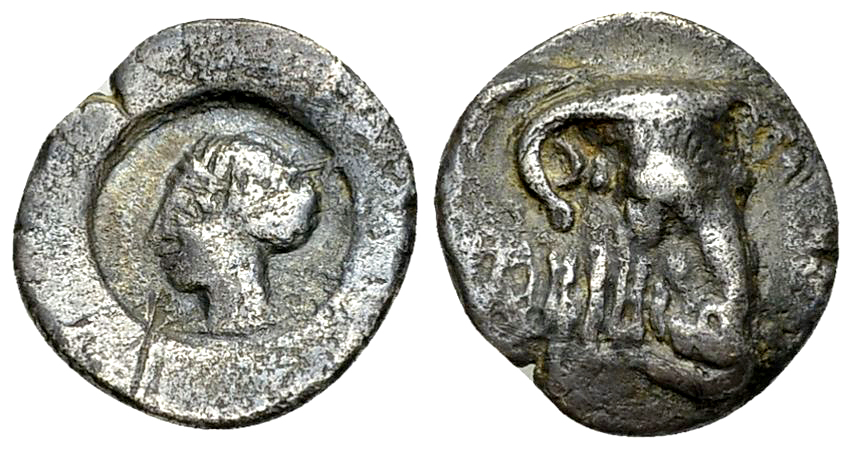S 1567 - Phaestus, silver, triobols (350-270 BCE)
From SILVER
350 BCE - 270 BCE Silver 535 kg
Description
| ObverseInscription or printing placed on the obverse.: | Female head (Europa) to left |
| ReverseInscription or printing placed on the reverse.: | Head of bull to right, slightly turned facing |
Mint and issuing power
| MintIdentifies the place of manufacture or issue of a numismatic object.: | Phaestus | Ancient regionAncient region.: | Crete | Modern countryModern country: Crete | AuthorityIdentifies the issuing power. The authority can be "pretended" when the name or the portrait of X is on the coin but he/she was not the issuing power. It can also be "uncertain" when there is no mention of X on the coin but he/she was the issuing power according to the historical sources: |
Chronology
| FromIdentifies the initial date in a range assigned in a numismatic context. | 350 BCE | toIdentifies the final date in a range assigned in a numismatic context.. | 270 BCE | PeriodTime period of the numismatic object.: Classical and Hellenistic |
Physical description
| MetalThe physical material (usually metal) from which an object is made.: | Silver |
Median weightMedian of the weights of numismatic objects (in grams). in grams | 2.80 | DenominationTerm indicating the value of a numismatic object. Examples: tetradrachm, chalkous, denarius.: | triobol |
StandardStandard.: |
Image

S 1567 - Phaestus, silver, triobols (350-270 BCE).jpg [1]
References
| Die study referencePublication of the study: | Carbone 20221Carbone 2022, p. 73 (Group E), 91-92 (Group J), 98-99 (Group M), 102 (Group O), 104 (Group P) | ||
| Coin series referenceReference to coin series study: | Sear I2Sear I, n° 3201, 3206 | ||
Obverse dies distribution
| FrequencyFrequency of specimen in distribution. ᵖ | Number of obversesNumber of obverse dies. ᵖ (o) | % (o) | Number of coinsNumber of coins. (n) | % (n) | Die nameName(s) of the die(s). |
| 1 | 2 | 22.22 | 2 | 3.33 | 26, 41 |
| 2 | 2 | 22.22 | 4 | 6.67 | 27, 36 |
| 5 | 1 | 11.11 | 5 | 8.33 | 8 |
| 6 | 1 | 11.11 | 6 | 10 | 35 |
| 10 | 1 | 11.11 | 10 | 16.67 | 24 |
| 15 | 1 | 11.11 | 15 | 25 | 25 |
| 18 | 1 | 11.11 | 18 | 30 | 43 |
| Total | 9 of 9 | 99.99 | 60 of 60 | 100 |
Reverse dies distribution
no distribution is available
Quantification
| Number of obversesNumber of obverse dies. ᵖ (o) | 9 | Number of singletons (o1)The number of singleton coins. ᵖ | 2 |
| Number of reverse diesNumber of reverse dies. (r) | Number of coinsNumber of coins. (n) | 60 | |
| Coins per obverse dieNumber of coins per obverse die. (n/o) | 6.67 | Coins per reverse dieNumber of coins per reverse die. (n/r) | |
| Reverse per obverse ratioRatio of obverse dies divided by reverse dies. (r/o) | Percentage of singletons (o1)number of coins (n) divided by the number of singletons (o1) ᵖ | 22.22 % | |
| Original number of dies (O) (Carter 1983 formula)The estimation of the number of coins according to Carter 1983 ᵖ | 9.55 | Coins struck if 20,000 as average productivity per dieCoins made if the average productivity for obverses (according to Carter) is 20,000. ᵖ | 191,000 |
| Original number of dies (O) (Esty 2011 formula)The estimation of the number of coins according to the singleton formula in Esty 2011 ᵖ (O) | 10.59 | Survival rate if 20,000 as average productivity per dieSurvival rate if average productivity is 20,000. ᵖ | 0.00031 |
| Coverage (o = % of O) (Esty 1984 formula)Esty 1984 - coverage (% of O) ᵖ (o = % of O) | 96.67% | Die productivity if survival rate 1/2,000Average productivity if survival rate is 1/2,000. ᵖ | 12,565.45 |
| Weight of silver (in kg) if 20,000 coins per die (O = Carter formula)Carter 1983 * Median weight * 20000 (*10 if gold or electrum) ᵖ | 535 kg <br /> 535 kg | Die productivity if survival rate 1/5,000Average productivity if survival rate is 1/5,000. ᵖ | 31,413.61 |
Remarks
Most likely one single workstation